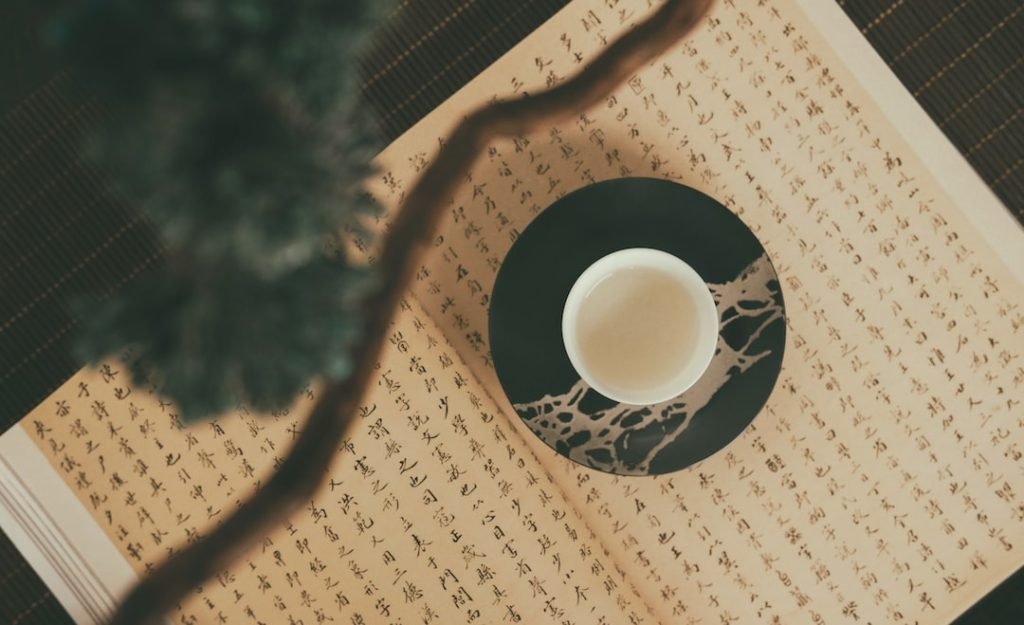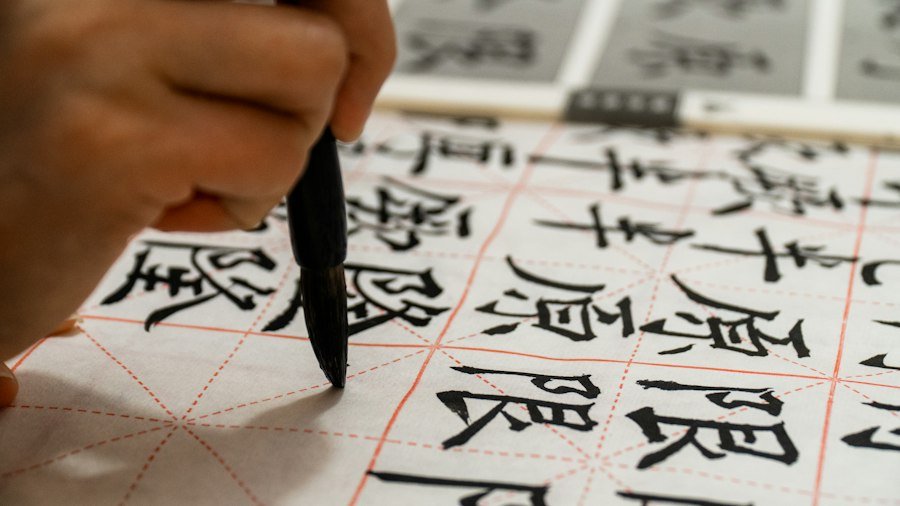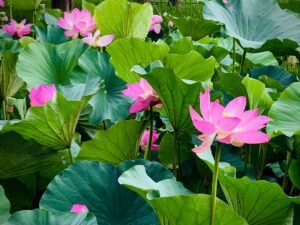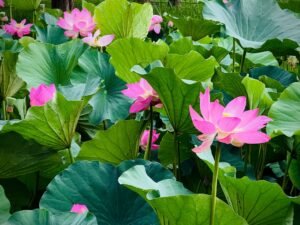

Expressing Yourself Through Art: Creative Vocabulary in Chinese
Chinese art has a rich and vibrant history that spans thousands of years. From ancient calligraphy to traditional painting styles, Chinese art has played a significant role in shaping the country’s culture and identity. Understanding Chinese art vocabulary is essential for appreciating and interpreting the meaning behind these artistic expressions.
Chinese art encompasses a wide range of mediums, including painting, calligraphy, sculpture, ceramics, and more. It reflects the country’s deep-rooted traditions, spiritual beliefs, and cultural values. By studying Chinese art vocabulary, one can gain a deeper understanding of the symbolism, techniques, and styles that are unique to this art form.
Table of Contents
ToggleBasic Chinese Art Terminology
To begin understanding Chinese art vocabulary, it is important to familiarize oneself with some basic terms. One such term is “guohua,” which refers to traditional Chinese painting. Guohua often depicts landscapes, flowers, birds, and other natural subjects using ink and brush techniques.
Another important term is “shanshui,” which translates to “mountain and water.” Shanshui paintings are a popular genre in Chinese art that focuses on landscapes. These paintings aim to capture the essence of nature and evoke a sense of tranquility and harmony.
Famous Chinese artists such as Qi Baishi and Zhang Daqian have made significant contributions to the world of Chinese art. Qi Baishi was known for his expressive brushwork and unique style, while Zhang Daqian was renowned for his ability to imitate the styles of ancient masters.
Colors and Their Meanings in Chinese Art
Colors play a significant role in Chinese art, as they are often used symbolically to convey meaning and evoke emotions. Red, for example, is associated with good luck, joy, and celebration in Chinese culture. It is often used in festive paintings or to depict auspicious subjects such as dragons or phoenixes.
Black is another color that holds symbolic meaning in Chinese art. It is associated with water and the element of yin, representing mystery, depth, and the unknown. Black ink is commonly used in calligraphy and ink paintings to create contrast and add depth to the artwork.
In contrast, white is associated with purity, simplicity, and mourning in Chinese culture. It is often used to depict snow, clouds, or other elements of nature that symbolize purity and tranquility.
Calligraphy and Brushwork Techniques
Calligraphy is considered one of the highest forms of art in Chinese culture. It involves the skilled use of a brush and ink to create beautiful characters that convey meaning and emotion. Calligraphy is not just a form of writing; it is also a visual art form that emphasizes the aesthetics of brushwork.
Different brushwork techniques are used in calligraphy to create various effects. For example, “xieyi” refers to a freehand style of brushwork that focuses on expressing the artist’s emotions and feelings. This technique allows for more spontaneity and fluidity in the strokes.
On the other hand, “gongbi” is a meticulous and detailed brushwork technique that requires precision and control. It is often used in traditional Chinese painting to depict intricate subjects such as figures or architecture.
Chinese Painting Styles and Techniques
Chinese painting encompasses a wide range of styles and techniques, each with its own unique characteristics. One such style is “gongbi,” which is known for its detailed brushwork and emphasis on realism. Gongbi paintings often depict figures, landscapes, or historical scenes with great precision and attention to detail.
In contrast, “xieyi” is a more expressive and freehand style of painting that focuses on capturing the essence of the subject rather than its exact details. Xieyi paintings often use bold brushstrokes and minimalistic compositions to convey emotions and feelings.
Another popular painting technique in Chinese art is “shui-mo,” which translates to “ink and wash.” This technique involves using ink and water to create various shades and textures, resulting in a more fluid and atmospheric painting style.
Traditional Chinese Art Forms

In addition to painting and calligraphy, traditional Chinese art encompasses a wide range of other art forms. One such art form is paper cutting, which involves the intricate cutting of paper to create decorative designs. Paper cutting is often used to create window decorations, lanterns, or other festive items.
Embroidery is another traditional Chinese art form that has been practiced for centuries. It involves the use of colored threads to create intricate designs on fabric. Chinese embroidery often depicts flowers, birds, or other natural subjects and is known for its meticulous craftsmanship.
Other traditional Chinese art forms include porcelain making, jade carving, lacquerware, and more. Each of these art forms has its own unique techniques and cultural significance.
Contemporary Chinese Art Trends
While traditional Chinese art forms continue to be celebrated, contemporary Chinese art has also gained international recognition in recent years. Contemporary Chinese artists are pushing boundaries and exploring new mediums and techniques to express their ideas and perspectives.
One current trend in contemporary Chinese art is the fusion of traditional techniques with modern themes and concepts. Artists are combining traditional ink painting techniques with digital technology or incorporating Western artistic influences into their work.
Artists such as Ai Weiwei and Xu Bing have made significant contributions to contemporary Chinese art. Ai Weiwei is known for his provocative installations and social commentary, while Xu Bing explores the intersection of language, culture, and identity through his artwork.
Expressing Emotions and Feelings through Chinese Art
Chinese art has long been used as a means of expressing emotions and feelings. Whether through calligraphy, painting, or other art forms, artists aim to convey their inner thoughts and experiences through their artwork.
For example, the use of bold and energetic brushstrokes in a painting can evoke a sense of excitement or passion. Soft and delicate brushwork, on the other hand, can convey a sense of tranquility or serenity.
Famous Chinese paintings such as “Along the River During the Qingming Festival” by Zhang Zeduan and “Dwelling in the Fuchun Mountains” by Huang Gongwang are known for their emotional depth and expressive brushwork. These paintings capture not only the physical landscapes but also the emotions and experiences of the artists.
Chinese Art and Cultural Significance
Chinese art is deeply rooted in Chinese culture and history, reflecting the country’s traditions, beliefs, and values. By studying Chinese art, one can gain insights into the cultural significance of various symbols, motifs, and artistic techniques.
For example, the use of dragons in Chinese art symbolizes power, strength, and good fortune. Dragons are often depicted in traditional paintings or sculptures to bring luck and protection.
Another example is the use of lotus flowers in Chinese art, which symbolize purity, enlightenment, and rebirth. Lotus flowers are often depicted in Buddhist art to represent spiritual awakening and transcendence.
Famous Chinese art pieces such as the Terracotta Army and the Forbidden City are not only masterpieces of craftsmanship but also important cultural symbols that represent China’s rich history and heritage.
Learning Chinese Art Vocabulary through Chinese Language Classes
Learning Chinese language can greatly enhance one’s understanding of Chinese art vocabulary. By studying Mandarin or Cantonese, one can gain access to a wealth of resources and literature on Chinese art.
There are many resources available for learning Chinese language and art vocabulary. Online platforms such as Duolingo, Rosetta Stone, and FluentU offer interactive language courses that cater to different proficiency levels.
In addition to language classes, there are also specialized courses and workshops that focus specifically on Chinese art and culture. These classes provide a more in-depth understanding of Chinese art vocabulary and techniques.
Understanding Chinese art vocabulary is essential for appreciating and interpreting the rich history and cultural significance of Chinese art. By familiarizing oneself with basic terms, colors, brushwork techniques, and painting styles, one can gain a deeper understanding of the symbolism and meaning behind Chinese art.
Chinese art reflects the country’s traditions, beliefs, and values, and studying it can provide insights into Chinese culture and history. Whether through traditional art forms or contemporary trends, Chinese artists continue to push boundaries and express their emotions and ideas through their artwork.
By learning Chinese language and exploring Chinese art, one can embark on a journey of discovery and appreciation for the beauty and complexity of Chinese culture. So why not dive in and explore the world of Chinese art?
If you’re interested in learning more about Chinese culture and traditions, you might also enjoy reading this article on traditional Chinese clothing. It provides a helpful guide to understanding the different types of clothing worn in China, including their historical significance and cultural importance. Check it out here!
Chinese vocabulary – Art
- 画 (huà) – painting
- 国画 (guó huà) – Chinese painting
- 水墨画 (shuǐ mò huà) – ink wash painting
- 山水画 (shān shuǐ huà) – landscape painting
- 花鸟画 (huā niǎo huà) – flower and bird painting
- 工笔画 (gōng bǐ huà) – meticulous painting
- 写意画 (xiě yì huà) – freehand brushwork painting
- 书法 (shū fǎ) – calligraphy
- 篆刻 (zhuàn kè) – seal carving
- 中国画家 (zhōng guó huà jiā) – Chinese painter
- 书法家 (shū fǎ jiā) – calligrapher
- 艺术家 (yì shù jiā) – artist
- 艺术品 (yì shù pǐn) – artwork
- 艺术展览 (yì shù zhǎn lǎn) – art exhibition
- 画廊 (huà láng) – art gallery
- 博物馆 (bó wù guǎn) – museum
- 艺术馆 (yì shù guǎn) – art museum
- 陶瓷 (táo cí) – ceramics
- 瓷器 (cí qì) – porcelain
- 青花瓷 (qīng huā cí) – blue and white porcelain
- 彩陶 (cǎi táo) – painted pottery
- 雕塑 (diāo sù) – sculpture
- 雕刻 (diāo kè) – carving
- 玉雕 (yù diāo) – jade carving
- 木雕 (mù diāo) – wood carving
- 石雕 (shí diāo) – stone carving
- 作品 (zuò pǐn) – work (of art)
- 创作 (chuàng zuò) – create
- 灵感 (líng gǎn) – inspiration
- 颜料 (yán liào) – paint
- 画布 (huà bù) – canvas
- 画笔 (huà bǐ) – paintbrush
- 宣纸 (xuān zhǐ) – rice paper
- 墨 (mò) – ink
- 砚台 (yàn tái) – inkstone
- 调色板 (tiáo sè bǎn) – palette
- 画架 (huà jià) – easel
- 草图 (cǎo tú) – draft
- 临摹 (lín mó) – copy (a painting)
- 绘图 (huì tú) – drawing
- 美术 (měi shù) – fine arts
- 美术馆 (měi shù guǎn) – art museum
- 绘画 (huì huà) – drawing
- 摄影 (shè yǐng) – photography
- 摄影师 (shè yǐng shī) – photographer
- 动画 (dòng huà) – animation
- 动画片 (dòng huà piàn) – animated film
- 漫画 (màn huà) – comic
- 卡通 (kǎ tōng) – cartoon
- 平面设计 (píng miàn shè jì) – graphic design
- 摄影展 (shè yǐng zhǎn) – photo exhibition
- 艺术节 (yì shù jié) – art festival
- 文化遗产 (wén huà yí chǎn) – cultural heritage
- 艺术表现 (yì shù biǎo xiàn) – artistic expression
- 瓷器艺术 (cí qì yì shù) – porcelain art
- 风格 (fēng gé) – style
- 主题 (zhǔ tí) – theme
- 抽象 (chōu xiàng) – abstract
- 现实主义 (xiàn shí zhǔ yì) – realism
- 印象派 (yìn xiàng pài) – impressionism
- 现代艺术 (xiàn dài yì shù) – contemporary art
- 艺术评论 (yì shù píng lùn) – art critique
- 艺术教育 (yì shù jiào yù) – art education
- 艺术市场 (yì shù shì chǎng) – art market
- 视觉艺术 (shì jué yì shù) – visual arts
- 表演艺术 (biǎo yǎn yì shù) – performing arts
- 壁画 (bì huà) – mural
- 装饰画 (zhuāng shì huà) – decorative painting
- 艺术欣赏 (yì shù xīn shǎng) – art appreciation
- 工艺品 (gōng yì pǐn) – craft
- 艺术形式 (yì shù xíng shì) – art form
- 艺术风格 (yì shù fēng gé) – art style
- 彩绘 (cǎi huì) – colored painting
- 装饰艺术 (zhuāng shì yì shù) – decorative arts
- 陶艺 (táo yì) – pottery
- 传统艺术 (chuán tǒng yì shù) – traditional art
- 现代艺术 (xiàn dài yì shù) – modern art
- 雕刻艺术 (diāo kè yì shù) – carving art
- 剪纸 (jiǎn zhǐ) – paper cutting
- 面塑 (miàn sù) – dough modeling
- 风筝 (fēng zhēng) – kite
- 风筝艺术 (fēng zhēng yì shù) – kite art
- 戏剧 (xì jù) – drama
- 戏曲 (xì qǔ) – Chinese opera
- 京剧 (jīng jù) – Peking opera
- 艺术治疗 (yì shù zhì liáo) – art therapy
- 艺术投资 (yì shù tóu zī) – art investment
- 艺术创意 (yì shù chuàng yì) – artistic creativity
- 艺术市场 (yì shù shì chǎng) – art market
- 艺术工作室 (yì shù gōng zuò shì) – art studio
- 艺术课程 (yì shù kè chéng) – art course
- 艺术中心 (yì shù zhōng xīn) – art center
- 艺术论坛 (yì shù lùn tán) – art forum
- 艺术展览会 (yì shù zhǎn lǎn huì) – art exhibition
- 艺术沙龙 (yì shù shā lóng) – art salon
- 艺术博览会 (yì shù bó lǎn huì) – art fair
- 艺术院校 (yì shù yuàn xiào) – art school
- 中国艺术 (zhōng guó yì shù) – Chinese art
- 民间艺术 (mín jiān yì shù) – folk art
- 传统文化 (chuán tǒng wén huà) – traditional culture
FAQs
What is the article about?
The article is about expressing oneself through art and the use of creative vocabulary in Chinese.
Why is it important to express oneself through art?
Expressing oneself through art can be a therapeutic and cathartic experience. It allows individuals to communicate their emotions and thoughts in a creative and unique way.
What are some examples of creative vocabulary in Chinese?
Some examples of creative vocabulary in Chinese include idioms, metaphors, and poetic language. These can be used to add depth and nuance to one’s artistic expression.
How can one improve their use of creative vocabulary in Chinese?
One can improve their use of creative vocabulary in Chinese by studying and practicing different forms of Chinese art, such as calligraphy, poetry, and painting. Additionally, reading and listening to Chinese literature and music can also help expand one’s vocabulary.
What are some benefits of expressing oneself through art?
Expressing oneself through art can help reduce stress and anxiety, improve self-esteem, and promote emotional well-being. It can also foster creativity and innovation, and provide a sense of accomplishment and fulfillment.
If you want to learn Norwegian, you can register for classes here. We look forward to hearing from you and helping you become fluent in Norwegian.





